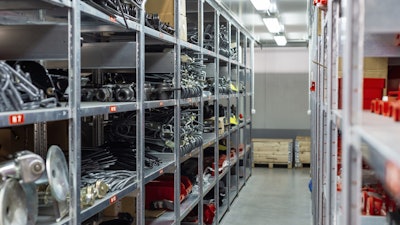
For any internal MRO management program, maintaining consistency in parts ordering, pricing, stocking, tracking, etc. is a significant hurdle. Consistency in staffing, corporate directives and discipline is essential, especially considering the disproportionately high amount of resources needed to properly manage MRO.
Experience demonstrates that managing MRO burns a significant portion of a company’s overall transactional costs. Up to 80 percent of a company’s time and resources spent sourcing materials and processing payments is spent on MRO materials. That’s a significant figure when you consider that a company’s MRO spend is typically less than 10 percent of the overall spend. So, 80 percent of transactional costs are burned on up to 10 percent of a company’s spend.
In a manufacturing environment when new production or packaging equipment is introduced so too is a new list of required spare parts, maintenance plans and other elements. But what happens to the previous equipment and its spare parts? In most cases, absolutely nothing. Parts remain in the storeroom waiting to be used. Over time, those parts become “lost” to the system. Additionally, the new spare parts are often purchased with a lack of regard for how often a specific part is needed, thus inflating inventory even further. The storeroom becomes bloated and finding parts becomes more challenging, further eroding maintenance efficiency.
There are typically two paths taken to addressing the challenges in managing MRO:
Manage the MRO using internal resources and historical knowledge
Outsource to a third-party service provider with an establish capability in MRO supply chain management, from sourcing to issuance (integrator).
Many organizations recognize they have a problem but react differently in seeking a solution. Some approach the challenge by solving it internally, focusing on one or two elements, like piece price. Some ignore it, hoping it will solve itself. Others are more strategic, willing to pass on short-term gains – or settle for limited gains – in order to earn long-term benefits in processes and efficiencies.
 iStock
iStock
The role of an integrator in an outsourced solution is to understand how decisions like purchasing new equipment impacts other elements of the MRO supply chain. The ability to recognize opportunities that drive savings, improve efficiency, and deliver value is what differentiates integrators from the other approaches.
That value is realized in any number of ways, including introduction of new supply chain management software, continued piece price savings, parts commercialization, point-of-use operations, centralized procurement services, etc. The point being that an integrated supplier has the resources available to drive sustained value more so than most internal operations.
Here are a couple of examples of value created by an integrator.
Asset Liquidation
The first example involves a life sciences manufacturing company based on the East Coast of the United States. The company manufactures a range of medical treatment options, including pain medication and vaccines. One of its manufacturing plants was looking to consolidate equipment, eliminating it from storage through disposal or other methods. The company’s on-site integrator – a long-standing relationship – developed a physical asset liquidation program – an online auction – designed to return value for the used equipment.
The integrator’s on-site team worked with the client in identifying 300-400 pieces of equipment – packaging equipment, kettles and tanks, filling equipment, inspection and processing equipment – some of which had been out of service for decades. The integrator team then cataloged the equipment, took pictures and coordinated with the client to identify what equipment could be included in the sale and what had to stay or get scrapped.
The online auction was active for about a month, returning more than a quarter million dollars in realized savings. The program success is driving additional asset relocation programs at the same site and others owned by the client.
Procurement Process Review
Successful examples, however, are not about a singular event, but how a strong process realizes significant gains over time. For a third client, a large manufacturer on the West Coast of the United States, a procurement-only arrangement with an integrator eventually grew to a full-service program after a review of activity revealed a savings opportunity.
The storeroom itself was managed by the company’s on-site union personnel, who were responsible for managing the inventory and establishing min/max order points. Traditionally, the storeroom attendant on duty would record on paper when items needed to be ordered and share that information with procurement.
Through implementation of its disciplined procurement process, the integrator peeled back layers of the operation, exposed savings opportunities and created overall process improvement.
In one such case, an order was received for 12 identical spare parts because existing stock fell below the required minimum. However, because of the integrator’s expertise and technology, additional research revealed that those 12 pieces represented a 10-year supply for the client.
Further analysis of the company’s purchasing data uncovered multiple examples of duplicate parts supplied by different manufacturers or having different brand names. In one case, duplicate elbow fittings were discovered listed under four different brand names. By communicating with the client and limiting the part to a single brand, the company reduced inventory and saved significant costs. The client saw a 30 percent reduction in inventory levels over three years, equating to $2 million in savings.
In each one of these examples, and the dozens more available, the integrator did not act alone. Client teams were heavily involved, adding tribal insight that an  Dave Juul
Dave Juul
Dave Juul is the Vice President of Operations for Synovos, an MRO integrated supply chain management services company. Among his responsibilities is implementing and delivering supply chain management programs that lower costs and improve maintenance effectiveness for clients. He can be reached at [email protected].



















